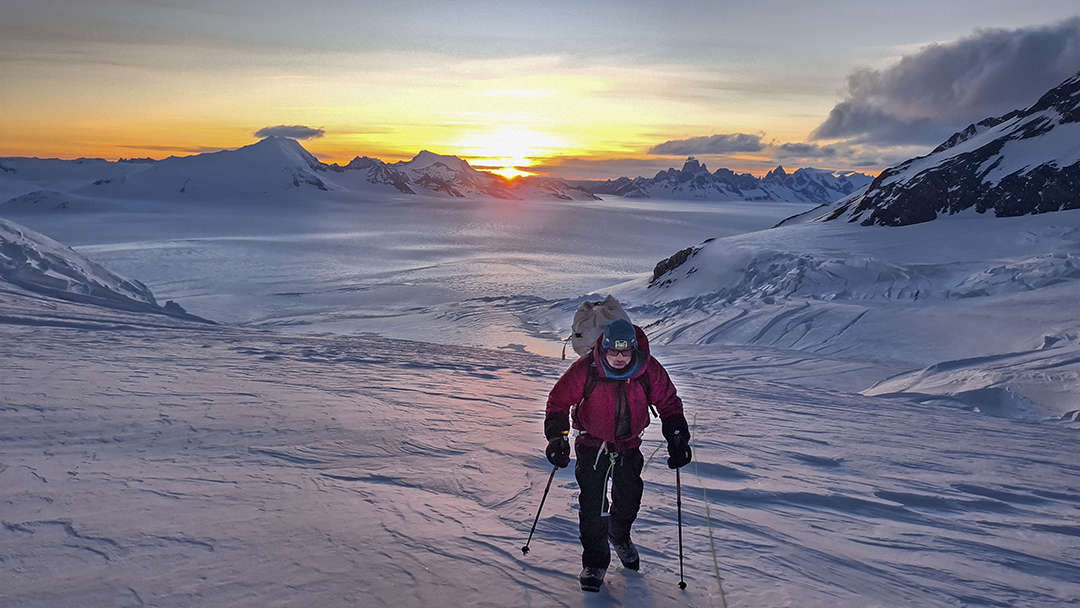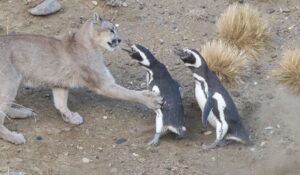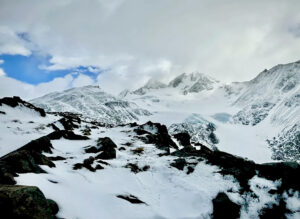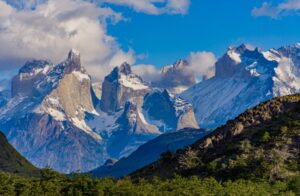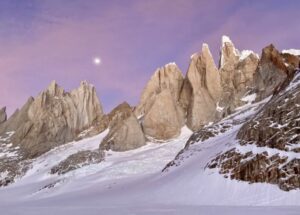The Southern Patagonian Ice Field’s vicious weather offers climbers far more options for suffering and failure rather than for success. Pablo Besser and Elias Lira’s double header of the Lautaro volcano (3,609m) and Perito Moreno Peak (3,442m) is a rare stroke of luck. It also shows the Chileans’ deep knowledge of the area.
“While not technically challenging, these are the two highest peaks in the Southern Patagonian Ice Field and very elusive due to the weather,” Besser told ExplorersWeb. “We were lucky to catch a window of good weather that allowed us to do both.”
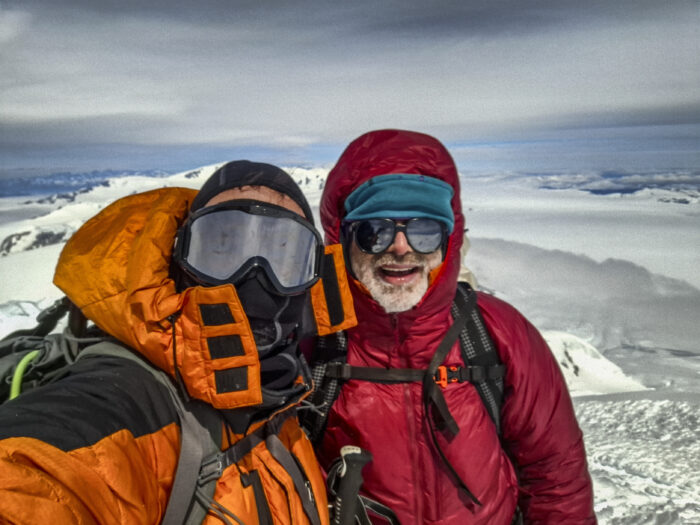
Elias Lira and Pablo Besser during a good day on the Patagonian Ice Field. Photo: Elias Lira
Patagonia regulars
This was Besser’s seventh visit to the Southern Patagonian Ice Field, including a 400km north-south traverse 25 years ago. Elias Lira had climbed San Valentín, the highest peak in Patagonia, 10 years earlier. Besser had attempted Lautaro twice before, but bad weather never let him set even one foot on its flanks. This was the primary goal of the expedition.

The Southern Patagonian Ice Field. Photo: Pablo Besser
Both Lautaro and Perito Moreno Peak are located in the Cordon (local name for range) Mariano Moreno*. They are the highest peaks on the Ice Field, and the third and fourth highest in Patagonia, after San Valentín and San Lorenzo. The challenge here, however, is not the altitude but how to reach the peaks.
The few expeditions to Lautaro opt to hurry there during a brief spell of good weather. The idea is to stay as briefly as possible on the Ice Field, which poses a serious challenge in bad weather. The Chilean team, however, entered the ice via Marconi Pass in Argentina, with gear and food for 20 days, hauling sleds on skis. They were at least somewhat prepared to wait out Patagonia’s notoriously fickle weather.

One of the camps. Photo: Pablo Besser
Getting there
“We entered on October 28 through Piedra Fraile, then hiked across the Lago Electrico to camp next to the new tin shelter being built by the Patagonia Refuges team,” said Besser. (The shelter was closed.)
They spent the second night at the edge of the ice at another campsite, the Laguna de los 14. Besser went on:
On November 1, we arrived at the García Refuge, which was unoccupied and open, with plenty of food. On November 4, we camped at the foot of Lautaro.
The base is at 1,500m, which is the average altitude of the Patagonian Ice Field. Lautaro doesn’t have many options for safe intermediate camps protected from avalanches or seracs, so the summit day definitely requires gaining its 2,100 vertical meters in a single push.
On November 4, the weather started to improve. The following day at 3 am, they began climbing. Their single push took them 11 hours from base camp to summit, and six more hours to go down.
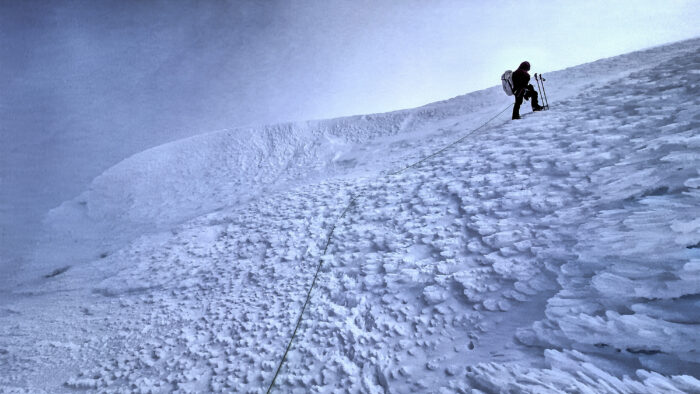
On Lautaro as the sky clears. Photo: Pablo Besser
Almost missed the summit
Besser recalls the climb as follows: “At the 3,000m pass, the sky darkened as clouds rolled in from the Pacific. For two hours, we wandered around, searching for the summit with only our GPS. We almost missed it!”
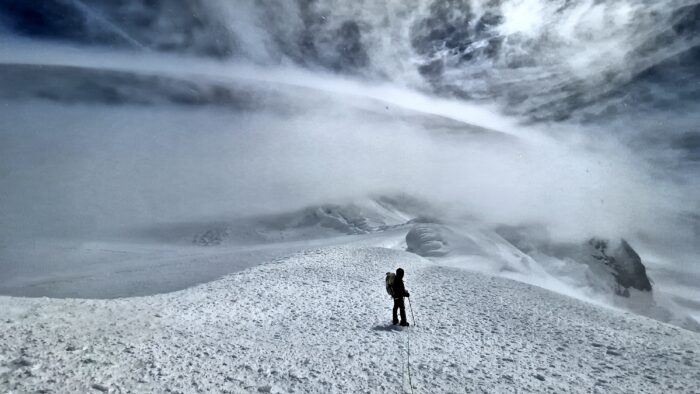
One of the climbers on the summit area of the Lautaro volcano. Photo: Pablo Besser
We reached the first dome, circled it, and arrived at the center of the volcano’s caldera. There were fumaroles in a circle around this snow plain. We saw few crevasses, but the [ones we saw] were fumarole crevasses, which are like caves and should be avoided. Right before the summit, the clouds parted and we enjoyed beautiful 360˚ views at 2 pm. We could see Lake Greve in the Pacific, which I traversed on a packraft last year.
After Lautaro, Besser, and Lira took a rest day, they put their skis back on and pulled their sleds for two days to the foot of Perito Moreno peak.
“On November 9, again at 3 am, we set off under the moon. The ice was completely lit up at night,” Besser recalls.
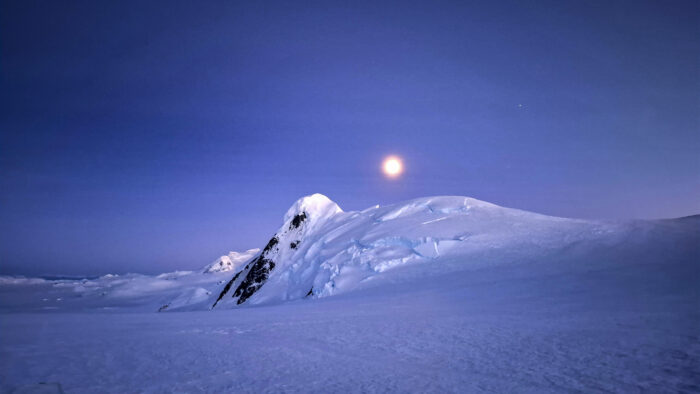
Mariano Moreno peaks under a full moon. Photo: Pablo Besser
By dawn, we were already on the shoulder. We changed gear, switched to skis, and skied to the supposed summit. But it was a sub-summit; the highest point was a little further back.
We reached the summit of Perito Moreno in 7 hours. The cordon Fitz Roy is remarkable from there, and there is a beautiful line of peaks to the south: Riso Patron, the Cerro Murallon, and even…Pietrobelli, already far away.
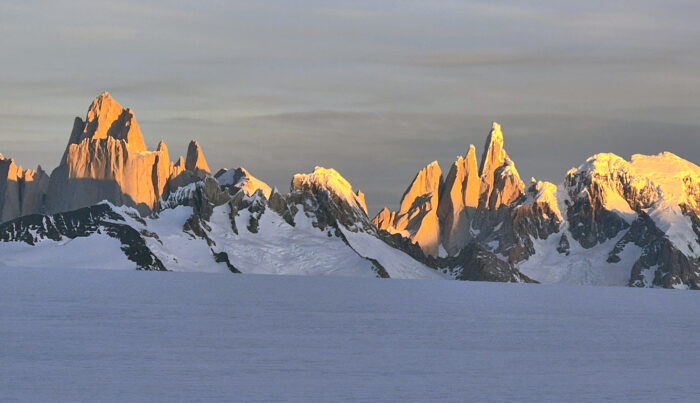
Views of the Fitz Roy and Cerro Torre massifs. Photo: Pablo Besser
They were the first Chilean team to reach its summit. It was also the first time that the two peaks were climbed on a single expedition.

Besser on the summit of Perito Moreno. Photo: Pablo Besser
Escaping the storm
They descended quickly in intense heat. By the following morning, the weather had worsened significantly.
A major storm was approaching. It was the same gale that took the lives of five trekkers in the Torres del Paine area.
“We immediately set off, hoping to reach the Eduardo Garcia refuge, which was about 23km away,” said Besser.
This refuge was built at the foot of Cerro Gorra Blanca around 20 years ago and is commonly used by those entering the Ice Field via Marconi Pass.

The expedition’s route on the Patagonian Southern Ice Field. Topo by Pablo Besser
The pair spent two days in the refuge. On November 13, they resumed their descent toward the Piedra Fraile campground.
“We arrived in the afternoon, but since we had no money, they wouldn’t let us camp, so we continued a little further into the Patagonian forest in the middle of an old-fashioned downpour!” said Besser.
There was also thunder and lightning, which he had never seen in three decades of Patagonian expeditions. “Electric storms are not common in this area,” he told ExplorersWeb.
Pioneers and global warming
Back in Calafate, Besser and Lira met glaciologist and mountaineer Pedro Skvarca, one of Lautaro’s first summiters in 1964. He shared memories and anecdotes about that pioneering climb.
During that first ascent, Pedro Skvarca of Slovenia and Luciano Pera of Argentina had to deal with heavily crevassed terrain, seracs, cornices, and a snow mushroom near the summit. They also found an active crater emitting sulfur near the top.

Left to right, Elias Lira, Pedro Skvarca, and Pablo Besser in El Calafate. Photo: Pablo Besser
Besser says that climate change has led to more periods of good weather on the Southern Patagonian Ice Field. Good weather of any kind was extremely rare in the late 20th century.
“I see subtle changes, like four- to five-day weather windows that were rare before,” he said.
When Besser crossed the Ice Field in 1998, he only had five good days out of 98! Lightning storms were unusual then. On the other hand, the lenticular clouds that used to announce approaching bad weather in Patagonia are seemingly gone now.
“I have not seen them in years,” he said. “They were beautiful and threatening at the same time.” Finally, there are more crevasses in the ice.
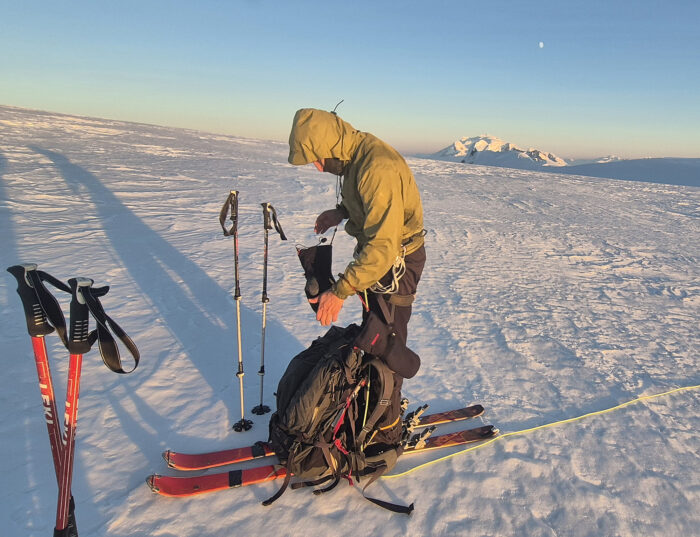
One of the climbers, with Lautaro in background. Photo: Pablo Besser
*A note on names
Perito Moreno, the highest peak of the Cordon Mariano Moreno (named after an Argentine politician), is named after a different person with the same surname. Francisco Pascasio Moreno was a geographer and explorer with a fascinating biography who took part in the commission that defined the borders between Chile and Argentina. He also gave his name to the most famous glacier in Patagonia.
